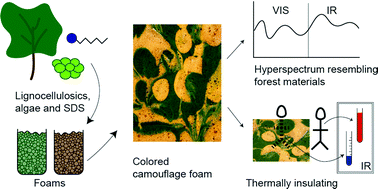Microalgae Chlorella vulgaris and kraft lignin stabilized cellulosic wet foams for camouflage†
Abstract
Plants, animals, and humans use camouflage to blend in with their surroundings. The camouflage is achieved with different combinations of colors, patterns, and morphologies. In stealth applications, the simplest camouflage uses textiles colored similarly to the environment to create an illusion. However, often, visible light range camouflage is not enough since the multispectral detection technologies of today are readily utilized for identification. Foams can be created with a straightforward fabricating process, and lightweight material exhibits good thermal insulation properties, providing stealth in the infrared light region. Herein, we produce cellulosic wet foams from surfactant and bleached pulp or cellulose nanofibrils. The visible light camouflage is created with green microalgae, Chlorella vulgaris, and brown kraft lignin, which also stabilized the foams. The thermal and spectral camouflage performance of foams was influenced by the cellulose content as well as the stability and water content of foams. Overall, these results give insight into how stability impacts the thermal and spectral properties of wet foams and provide a solid base for further material development to improve camouflage performance. While there is plenty of data on dry foams, the functional behavior of wet foams is currently not well known. Our method, using plant-based components can be exploited in a variety of other applications where simplicity and scalability are important.



 Please wait while we load your content...
Please wait while we load your content...